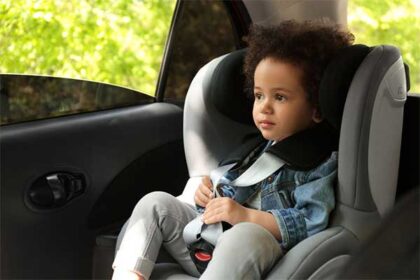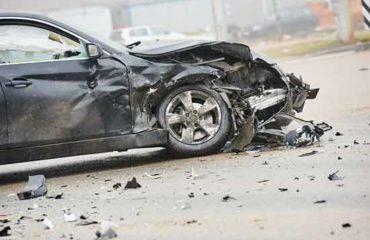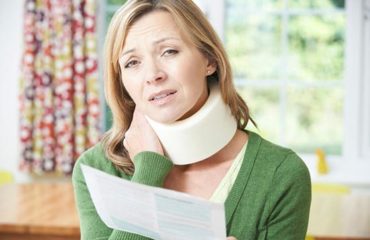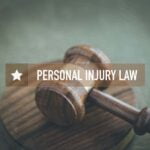Common Car Accident Injuries that Children Sustain

In October, 2019, a motorist plowed into 4 children who were walking to their school in Overland Park, as he drove right through a red light. About a month later, 4 children were killed along with their mother in a grisly Thanksgiving morning accident in a nearby county.
Earlier in 2020, two children were grievously hurt while being driven through a winter storm in McPherson County. In August, a two year old from Topeka was hit by a car and sustained life threatening injuries.
Unfortunately and understandably, children have a higher risk of sustaining serious injuries when in a car accident. This explains why motor vehicle crashes are a leading cause of unintentional injuries and deaths in minors.
But the truly shocking figure is this; in more than 60% cases where children sustained injuries in a car crash, the minor was correctly and appropriately restrained.
So, one thing is clear, every time your child is out on the road, whether as a passenger in a car, as a pedestrian or as a bicyclist, risks lurk at every corner. So, continue reading to know about the most common car accident injuries that children sustain and the factors that impact their severity.
The most common injuries sustained by children in car accidents!
1. Traumatic brain injury: Cerebrum injuries occur most frequently in children who are in motor vehicle accidents. While kids below the age of twelve months are most likely to suffer concussions and unconsciousness, those in the age group of 1-7 years have a very high risk of suffering from skull base fractures.
It goes without saying, head injuries can have devastating ramifications on the developing brain of a young child. Unfortunately, nearly 70% of all infants and more than half of all toddlers who sustain injuries in motor vehicle accidents (MVA) are found to have head trauma.
2. Thoracic injuries: Just as serious as head injuries, a hit to the chest area can do damage to multiple organs in the thoracic regions, including the lungs and the heart. Among children younger than 1 year of age, rib fractures were the most common, possibly due to the softness of the bones. Most children in the age group of 1-7 years who sustain chest injuries have contusions and lacerations to the lungs.
3. Spinal injuries: Although not as common as head and chest injuries, nearly 16% of all children injured in MVAs, who are below the age of 12 months, suffer from vertebral fractures, herniated discs and even spinal and nerve damage. However, instances of spinal trauma are less common in children who are 1-7 years old.
4. Abdominal injuries: The viscera houses nearly all major organs, which means that injuries in this part of the body can impact the liver, the digestive system, the kidneys, the reproductive system and more. Tragically, trauma to the small and large intestines is the second most common type of injury suffered by children in the age group of 4-7 years. Infants and toddlers fare worse with liver and spleen damage being the most common abdominal trauma experienced in the 1-3 year age group.
5. Injuries to the upper extremities: Humerus or upper arm fractures are most common when children suffer trauma to the upper extremities. However, it is the clavicle or the collar bone that is most at risk when the victims are below 1 year of age.
6. Lower extremities: Infants have a higher risk of a pelvic fracture as a result of a car crash than children in the age group of 1-7 years. Because toddlers and older children tend to have their legs dangling out of their car seats, thigh bone fractures are more common in children who are 1 to 7 years old.
7. Facial injuries: These are rare, with an occurrence rate between 5% and 10 %, but they often cause visible, long-term and sometimes permanent scarring. This can have a huge impact on the child’s social and psychological well-being as he/she grows.
8. Mental trauma: It goes without saying that if there is an injury involved, the pain will follow, both physical and psychological. But a terrifying incident like a car accident can leave a child severely traumatized even he does not have a scratch on him.
Several studies conducted to understand the psychological ramifications of being in a car crash on a child have shown that months after the incident over 30% of the minor victims continue to experience moderate psychological effects while over 10% show signs of severe mental distress.
More than one half of such children suffer from posts traumatic stress symptoms, while almost 40% display clear signs of travel anxiety and almost 25% are notably depressed. Sleep difficulties, anger and emotional outbursts, irritability and fear are also common. Adults also experience most of these post-crash mental effects, but children may continue to suffer from both the behavioral, developmental and cognitive repercussions of these effects for years to come.
Factors that influence the severity of car crash injuries in children
1. Roll overs: These are among the most dangerous types of accidents, causing the most severe injuries to even adult occupants. So you can imagine the impact of the destructive force on the body of a child. Fortunately, roll-over accidents are rare, but when they do occur, nearly 10-15% children who are involved in such crashes sustain incapacitating injuries.
2. Lack of appropriate child restraint: Regardless of the point of impact, children who are not appropriately restrained have a significantly higher risk of suffering from incapacitating physical trauma. For instance, even in roll-over accidents, only 9% children who are properly restrained suffer serious injuries. Compare this with the almost 30% unrestrained kids, who suffer significant physical trauma and it is easy to see these safety measures are important.
3. Front seat rides: Children below the age of one year are less likely to be travelling in the front row, but parents are more at ease with a 4 year old child in the front seat. But this can be a dangerous mistake because children seated in the front row have twice the risk of suffering from significant physical trauma in case of a head-on collision.
4. Side way crashes: While side impact accidents lead to less severe injuries and a lower incident rate of physical trauma to a child occupant, the lack of restraint can turn the tides against the passengers. So, only about 1% minor passengers suffer injuries if they are wearing at least their lap and shoulder harnesses. But the risk of incapacitating injuries soars to a massive 8 times more for children who are unrestrained.
5. Rear end crashes: Of all automobile accidents, rear end crashes have the lowest incident rate of causing significant injuries to minor occupants of the car. Yet, the fact is that regardless of the seating position in the vehicle, rear end crashes have a high risk of causing neck injuries, soft tissue damage and concussions.
The biggest problem is that such trauma is hard to diagnose and may not cause immediate discomfort. To add to the issue, if it is a toddler or an infant who was injured, the child may not be able to express the discomfort till there is serious damage done.
So, even though a fender bender may not be as dangerous as a front end dash, these accidents will still leave you with enough to worry about if you had your kid in the vehicle with you at the time of the accident.
6. Bicycle and pedestrian accidents: Despite the use of restraints and car seats and while being surrounded by a metal cage, kids can be exposed to life threatening injuries in a car crash. So, imagine the severity and the extent of injuries when the child does not get the protection of the vehicle and the safety features.
Nationally, around 10% of all unintentional injury deaths among children involve pedestrian injuries while another 2% are attributed to bicyclist injuries. In Kansas, the rate of emergency room visits due to such injuries stands at 20.0 per 100,000 children for pedestrian injuries and at 158 per 100,000 children for bicyclist injuries.
In 2016, more than 40 kids lost their lives due to unintentional injuries sustained in automobile accidents and almost 1200 children were injured in vehicle crashes across Kansas. Such accidents are common, dangerous and they can leave you grappling with medical costs that run into thousands of dollars.
So, what should you do if your child is injured in a car accidents?
If your child has suffered physical trauma in an automobile crash that occurred due to the negligence of another person, you have the legal right to claim compensation on behalf of your child.
At DeVaughn James, our experienced attorneys have handled hundreds of claims for minor victims and their parents. Our lawyers know what it takes to get compensation for the physical injuries and the mental agony suffered by the child as well as the long term detrimental effects of such trauma.
Contact us today and we will fight to get your child the compensation they deserve!









